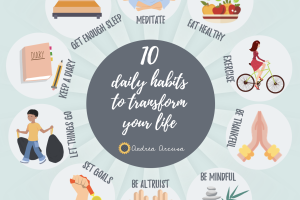Strategies for Integrating Good Living into Your Daily Routine

What is Good Living?
Good living encapsulates a holistic approach to life that prioritizes well-being, happiness, and fulfillment. It is not solely about physical health but also includes mental, emotional, and social dimensions. This concept encourages individuals to engage actively with their surroundings, cultivate meaningful relationships, and pursue passions that ignite joy. An example of good living might involve choosing to go for a nature walk rather than spending hours in front of a screen, allowing one to connect with nature and recharge.
- Strategies for Integrating Good Living into Your Daily Routine
- What is Good Living?
- Importance of Integrating Good Living into Daily Routine
- Setting Goals for Good Living
- Identifying Key Areas for Improvement
- Creating S.M.A.R.T. Goals
- Prioritizing Self-Care
- Establishing Daily Self-Care Practices
- Finding Balance in Work and Personal Life
- Cultivating a Positive Mindset
- Practicing Gratitude and Mindfulness
- Overcoming Negative Thought Patterns
- Implementing Healthy Habits
- Incorporating Exercise into Daily Routine
- Making Nutritious Food Choices
- Enhancing Relationships and Social Connections
- Building Supportive Relationships
- Strengthening Communication Skills
- Managing Stress Effectively
- Stress-Reduction Techniques
- Time Management Strategies
- Embracing Personal Development
- Seeking Continuous Learning Opportunities
- Discovering and Pursuing Passions
- Creating a Restful Sleep Routine
- Establishing a Bedtime Ritual
- Improving Sleep Environment
- Practicing Gratitude and Acts of Kindness
- Cultivating Gratitude Daily
- Engaging in Random Acts of Kindness
Importance of Integrating Good Living into Daily Routine
Incorporating good living into daily routines is essential for fostering a balanced and enriching lifestyle. When people actively embrace practices that enhance their well-being, they often experience:
- Increased happiness
- Reduced stress levels
- Improved physical health
- Stronger relationships
Integrating good living can be as simple as setting aside time each day for self-care or engaging in mindfulness practices. Such small yet impactful changes can lead to long-term benefits, transforming everyday life into a journey of health and joy.
Setting Goals for Good Living
Identifying Key Areas for Improvement
As individuals embark on their journey toward good living, the first step is identifying key areas for improvement. Reflecting on different aspects of life—such as health, relationships, career, and personal growth—can illuminate where changes are needed. For instance, someone may notice that they often feel fatigued or stressed, signaling a need to focus on self-care or stress management. Consider the following areas for enhancement:
- Physical Health: Nutrition and exercise
- Mental Well-being: Stress management and mindfulness
- Relationships: Building support systems and communication
- Personal Growth: Hobbies and lifelong learning
Creating S.M.A.R.T. Goals
Once the key areas for improvement are identified, it’s time to create S.M.A.R.T. goals—Specific, Measurable, Achievable, Relevant, and Time-bound. For example, instead of saying, “I want to get fit,” a S.M.A.R.T. goal would be, “I will jog for 30 minutes, three times a week, for the next three months.” This framework allows individuals to set practical goals that motivate and guide them toward positive changes, leading to the fulfillment associated with good living.
Prioritizing Self-Care
Establishing Daily Self-Care Practices
With S.M.A.R.T. goals in place, it’s essential to prioritize self-care, laying the groundwork for good living. Daily self-care practices can greatly enhance overall well-being. These practices might include engaging in activities that recharge the mind and body, like:
- Meditation: Taking just ten minutes to breathe and center oneself can lower stress levels.
- Exercise: A brisk walk or yoga session helps in boosting endorphins.
- Journaling: Writing down thoughts fosters reflection and clarity.
Personal stories often highlight the impact of dedicated self-care. For instance, someone might share how establishing a morning routine that includes a healthy breakfast and some stretching exercises has entirely transformed their day.
Finding Balance in Work and Personal Life
Equally important is finding a balance between work and personal life. Many individuals struggle to detach from their jobs, often leading to burnout. Here are some strategies to create that much-needed balance:
- Set Boundaries: Define working hours and stick to them.
- Schedule “Me Time”: Carve out time for hobbies, family, and rest.
- Practice Saying No: Assess commitments and avoid overextending oneself.
By actively prioritizing self-care and achieving a healthy work-life balance, individuals pave the way for a more fulfilling and vibrant life, essential components of good living.
Cultivating a Positive Mindset
Practicing Gratitude and Mindfulness
Building on the foundation of self-care, cultivating a positive mindset is crucial for embracing good living. One effective way to foster positivity is through gratitude and mindfulness practices. Taking a few moments each day to reflect on what one is thankful for can shift focus from negative to positive aspects of life. For example, jotting down three things to be grateful for before bed fosters a sense of contentment and joy. Mindfulness, on the other hand, encourages living in the present moment. Engaging in activities such as:
- Mindful breathing exercises: Help center thoughts and lower anxiety.
- Nature walks: Promote awareness and appreciation of surroundings.
- Mindful eating: Encourage savoring each bite, promoting healthier choices.
Overcoming Negative Thought Patterns
While cultivating positivity, individuals must also confront negative thought patterns that can be detrimental to their overall well-being. Identifying triggers for negative thinking is the first step. Techniques like:
- Cognitive reframing: Challenging thoughts by considering alternative perspectives.
- Affirmations: Repeating positive statements can create a more favorable self-image.
For instance, someone might replace, “I can’t do this” with “I’ll try my best today.” By actively practicing gratitude, mindfulness, and overcoming negativity, individuals can create a positive mindset that supports their journey toward good living, enriching their daily experiences.
Implementing Healthy Habits
Incorporating Exercise into Daily Routine
Continuing the journey toward good living, implementing healthy habits is vital. One of the most impactful habits is incorporating exercise into daily routines. Regular physical activity not only enhances physical health but also boosts mental clarity and mood. It can be as simple as:
- Walking: A brisk 20-minute walk during lunch breaks.
- Home Workouts: Using online videos for strength training or yoga.
- Active Commutes: Cycling or walking to work when possible.
Personal stories often emerge about discovering joy in movement. For example, someone might share their experience of joining a local dance class, ultimately finding both fitness and community.
Making Nutritious Food Choices
Alongside exercise, making nutritious food choices is crucial for overall health. Opting for wholesome, unprocessed foods can significantly enhance energy levels. To facilitate better eating habits, consider:
- Meal Prepping: Preparing healthy meals in advance saves time and reduces the temptation for fast food.
- Choosing Whole Foods: Incorporating plenty of fruits, vegetables, and lean proteins into diets.
- Hydration: Drinking enough water throughout the day.
A compelling example is a person who initially struggled with fast food but transitioned to cooking at home, discovering a love for fresh ingredients. By prioritizing exercise and nutrition, individuals lay down the foundation for vibrant health and well-being, complete with the energy needed to pursue a fulfilling life.
Enhancing Relationships and Social Connections
Building Supportive Relationships
As individuals implement healthy habits, enhancing relationships and social connections becomes vital for sustaining good living. Building supportive relationships fosters a sense of belonging and reduces feelings of loneliness. Engaging with friends, family, or community groups can significantly increase emotional well-being. Consider these tips for nurturing relationships:
- Regular Check-Ins: Set aside time each week to contact loved ones, whether through calls, texts, or visits.
- Participate in Activities: Join community events or classes to meet new people and share interests.
- Offering Support: Reach out to others when they need help; it strengthens bonds.
For example, someone might share how a simple coffee date with an old friend rekindled their friendship and provided emotional support during a challenging time.
Strengthening Communication Skills
Alongside nurturing relationships, strengthening communication skills is essential. Effective communication fosters understanding and trust. Here’s how to enhance these skills:
- Active Listening: Practice listening without interrupting; it shows genuine interest in others’ thoughts and feelings.
- Expressing Emotions: Gently sharing feelings can create deeper connections.
- Nonverbal Cues: Pay attention to body language, which can often convey more than words.
By engaging in open dialogues and expressing oneself clearly, individuals enhance their relationships and social connections. This focused effort on communication not only promotes healthier interactions but also contributes significantly to a satisfying and joyful life.
Managing Stress Effectively
Stress-Reduction Techniques
With supportive relationships and effective communication established, managing stress effectively is the next crucial step in the journey toward good living. Stress is inevitable, but employing stress-reduction techniques can make a significant difference. Some popular methods include:
- Deep Breathing Exercises: Taking slow, deep breaths helps calm the mind and body.
- Mindfulness Meditation: Spending just a few minutes each day being present can reduce anxiety.
- Physical Activity: Engaging in any form of exercise releases endorphins, improving mood and energy.
A personal anecdote might involve someone discovering the benefits of yoga, finding that just a few sessions a week helped them manage life’s pressures with newfound resilience.
Time Management Strategies
In conjunction with stress reduction, honing time management strategies can greatly alleviate pressure. It allows individuals to prioritize tasks and allocate time effectively. Here are some practical strategies:
- Create To-Do Lists: Keeping track of tasks helps avoid overwhelming oneself.
- Set Priorities: Use methods like the Eisenhower Matrix to determine what’s urgent and important.
- Break Tasks into Smaller Steps: This approach can make daunting tasks feel more manageable.
For instance, someone may realize they can tackle a large project by distributing it into smaller, achievable milestones. By combining effective stress-management techniques with sound time management strategies, individuals can navigate daily challenges with greater ease and enjoy a more balanced lifestyle.
Embracing Personal Development
Seeking Continuous Learning Opportunities
Having established effective stress management and time management techniques, embracing personal development can further enrich one’s journey toward good living. One of the most valuable aspects of personal development is the commitment to continuous learning. This could be through:
- Online Courses: Websites like Coursera and Udemy offer a plethora of classes on various subjects, making learning accessible.
- Reading Books: Exploring different genres or subjects can broaden perspectives and inspire creativity.
- Attending Workshops: Engaging in local workshops allows for hands-on experience and networking with like-minded individuals.
A personal example can highlight how someone who always wanted to learn guitar finally took an online class, reigniting a lifelong passion and sparking joy.
Discovering and Pursuing Passions
In conjunction with learning, discovering and pursuing passions is crucial in personal development. Taking the time to identify what truly brings joy can lead to transformative experiences. This might involve:
- Trying New Activities: Exploring activities like painting, hiking, or cooking can reveal hidden interests.
- Joining Clubs or Groups: Being part of a community with shared interests fosters connection and motivation.
- Setting Personal Goals: Establishing short-term and long-term goals can help keep passions alive and focused.
For instance, someone might share their journey of finding joy in community gardening after initially trying it out of curiosity. By seeking continuous learning and pursuing passions, individuals can cultivate a fulfilling life enriched with purpose and excitement, essential components of good living.
Creating a Restful Sleep Routine
Establishing a Bedtime Ritual
As individuals continue their pursuit of good living, creating a restful sleep routine is essential. Quality sleep plays a critical role in mental and physical well-being. Establishing a bedtime ritual can help signal the body that it’s time to wind down. This could include:
- Limiting Screen Time: Avoiding screens for at least an hour before bed can reduce the impact of blue light on sleep quality.
- Reading: Engaging in a calming activity, like reading a book, can help ease the mind.
- Relaxation Techniques: Incorporating practices such as gentle stretching or deep breathing can promote relaxation.
For instance, one person might share how they now prioritize a nightly routine of herbal tea and a few minutes of meditation, resulting in better sleep quality and a more refreshed morning.
Improving Sleep Environment
In addition to bedtime rituals, improving the sleep environment is vital for restful nights. Consider these adjustments for a better sleep atmosphere:
- Optimal Temperature: Keeping the bedroom cool (around 65°F or 18°C) helps facilitate restful sleep.
- Darkness and Quiet: Using blackout curtains and white noise machines can enhance a peaceful sleeping environment.
- Comfortable Bedding: Investing in quality mattresses and pillows ensures physical comfort throughout the night.
By sharing personal experiences or subtle changes made to optimize the sleeping environment, individuals can find that better sleep directly contributes to overall well-being. With a consistent bedtime ritual and an improved sleep atmosphere, one can achieve restorative rest, enhancing the quality of each day.
Practicing Gratitude and Acts of Kindness
Cultivating Gratitude Daily
As individuals wrap up their journey toward good living, practicing gratitude can serve as a powerful tool for enhancing overall well-being. Cultivating gratitude daily shifts focus from what’s lacking to appreciating what one has. This can be integrated into daily life through simple practices:
- Gratitude Journals: Spend a few minutes each day writing down three things one is grateful for. This reflection can shift mindset and elevate mood.
- Mindful Appreciation: Take time during the day to savor little moments, like enjoying a warm cup of coffee or the beauty of nature.
For example, someone might recall how dedicating just a few minutes before bed to acknowledge positive experiences has significantly improved their outlook on life.
Engaging in Random Acts of Kindness
In tandem with gratitude, engaging in random acts of kindness can amplify feelings of connection and joy. Simple gestures can make a significant impact on both the giver and the receiver. Consider these acts:
- Compliments: Offering genuine compliments to strangers can brighten their day.
- Volunteering: Dedicating time to help others in need fosters community and purpose.
- Acts of Service: Small gestures, like holding the door open or helping a neighbor, create ripples of positivity.
By sharing personal encounters of how small acts of kindness led to unexpected connections, individuals can inspire others to embrace these practices. Together, cultivating gratitude and engaging in kindness reinforces deeper relationships and enriches one’s journey towards a fulfilling, good life.





